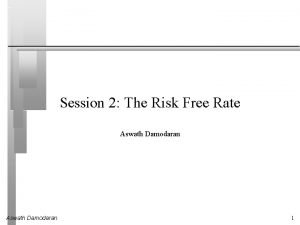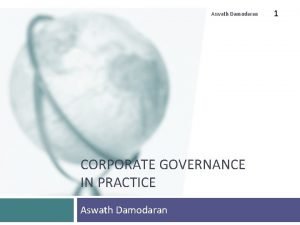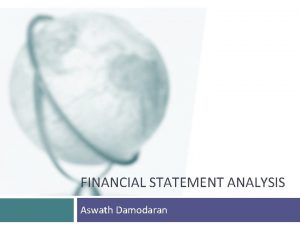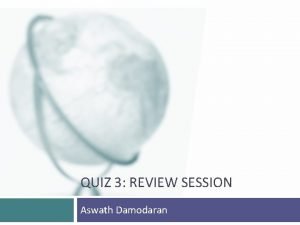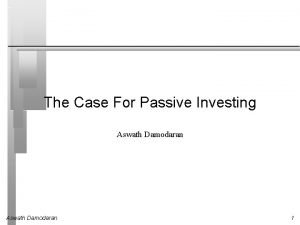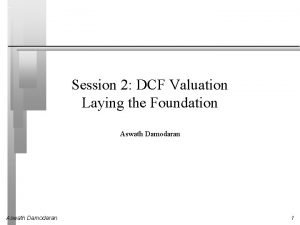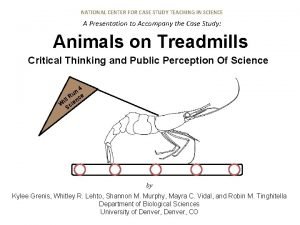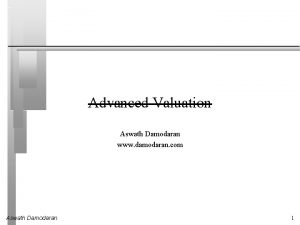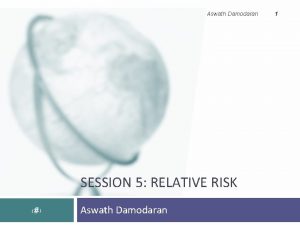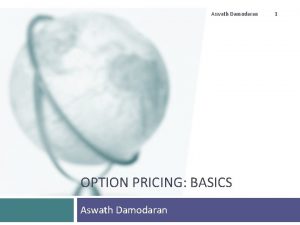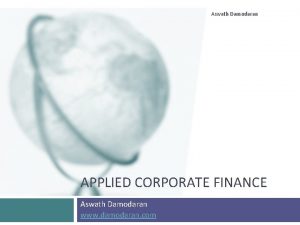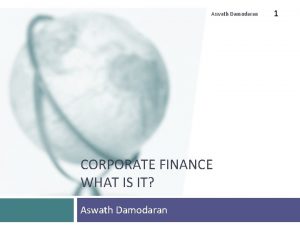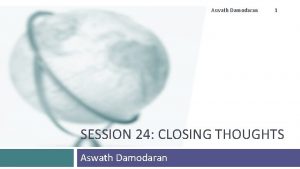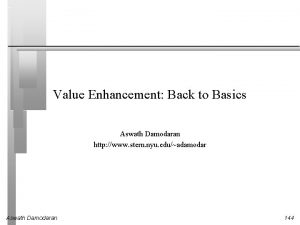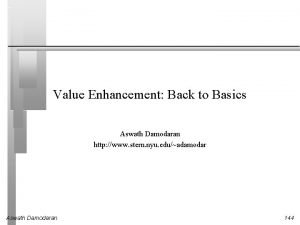TEACHING ART SCIENCE OR MAGIC Aswath Damodaran http











































- Slides: 43

TEACHING: ART, SCIENCE OR MAGIC? Aswath Damodaran http: //www. damodaran. com

The Mechanics of Teaching Impact factor: Did it change my perspective/thinking/life? 2

Exams, Grading and Office Hours The Dark Side of Teaching?

The importance of testing… Why do you give exams, quizzes or projects? a. b. c. d. e. Which of the following best describes your exam writing/grading philosophy? a. b. c. d. Because I am required to… Because it forces students to keep up with the material. . It is the basis for their grades. . All of the above None of the above (Give me your reason then. . ) I give easy exams but grade tough I give tough exams but grade easy I give easy exams and grade easy None of the above What are the characteristics a good grading system? Of a bad one? 4

Exams and Grading Tie exams to your course objective: Structure exams around what you want students to learn and not from ease of grading or other objectives. Make it difficult to cheat: People cheat… and even a few cheaters can create the perception that the grading is not fair. Assume that every past exam and its solutions are in the public domain Create multiple versions of the same exam. Have rules and enforce them. Speedy noisy feedback is better than perfect delayed feedback: Quick feedback is even more important for a large class than for a small one. Students have a much tougher time gauging how well or badly they are doing. Corollary: Unless you plan to religiously follow a textbook, avoid test banks. Give quizzes early and often in a class. Grade and return exams as quickly as you can Be fair: Listen to grading grievances and admit your mistakes. 5

Office hours and other delights… Do you enjoy having office hours? a. b. c. Yes No Sometimes If you dislike office hours, why do you dislike them? a. b. c. d. e. Being asked the same questions, over and over again. Too many administrative questions. Takes away time from more important things that I have to do (research, preparing for class) They are boring. I just don’t like students 6

Interaction outside the class Minimize administrative issues: Be as clear and decisive as you can be about the administration of the class and how you will be grading students. Learn from doubts/questions: Reduce the proportion of your office hours you are spending answering the same question over and over. If you are asked the same question more than three times by different students, either open a class by posing the question for the whole class and answering it (or) Developing a help manual for the class, where you start listing the questions with your answers and make the manual available to all students (or) Use technology. Put your help manual online. It makes searching easier Have an open-door policy. Being available does not mean that you will be inundated by students. 7

Some creative uses of email. . Reinforcing lessons from class Reminders of cases and exams coming due. Keep track of your outliers… Short summary of class right after class ends Newsletter at the end of each week Articles relating to the topic at hand (from business press…) Weekly challenges extending the concepts (optional) Valuation (CF analysis) of the week (optional) The Good outliers, who are interesting in delving deeper into the subject than you will be able to cover in class. The Neutral outliers, who hope to fade into the background. The Bad outliers, who have given up on the class Email Rules Set aside time to answer email. Do not view it as an imposition. If you open email, answer it. 8

IN THE CLASSROOM… These are some of the overheads I use in one class session in my corporate finance class where I introduce the question of how firms should raise money whether they should equity or debt.

The Classroom ① ② ③ ④ ⑤ Put it in context - provide the big picture and have a narrative. Be clear about where you are going before you take off. Explain why your subject matter is relevant. Frame topics to appeal to the widest audience Make it real ① ② ⑥ Keep people involved ① ② ⑦ Use real companies in real time Connect to everyday life. Active versus Passive participation Look for Aha! Moments Manage your time, don’t let the system beat you and trust your students. 10

1. Show them the big picture. . Corporate Finance: First Principles 11

Task 1: The Big Picture for the class you teach… Establishing a narrative Think about the big picture/ first principles that govern the class that you are teaching now. While doing this, Avoid the jargon that is endemic to every discipline Think in terms of the principles that govern how you think through problems in your discipline rather than on tactics or strategy. Put first principles in common sense terms Keep it compact (should fit on a page) Test it out by explaining what you are trying to do in your class to someone who does not know anything about your discipline and, better still, does not care. 12

2. Have a central question/theme for each class Session 16: The Financing Mix Question Background: This is session 16 of a 26 -session corporate finance class. It follows sessions where we have analyzed the investment principle. This session is built around one question. In deciding to raise financing for a business, is there an optimal mix of debt and equity? If yes, what is the trade off that lets us determine this optimal mix? If not, why not? 13

Task 2: The question of the day is…. Take your conventional syllabus, which usually lists the topics for each session. For each session in your class, outline the key question or questions that you hope to answer. In doing so, keep in mind that Most good lectures revolve around one question or perhaps two… Framing the question correctly will make it easier for your students to follow the class. Your lecture should revolve around answering the question. 14

3. Motivate the discussion Every business, small or large, private or public, has to choose a mix of debt and equity to fund it’s operations. It is possible that there exists a mix of debt and equity that is best for each business, and that the mix could be different for different businesses. If such a mix exists, we should try to find it even though we may be constrained by internal and external factors from moving to that mix. 15

Task 3: Make it relevant For each lecture in your class, explain why answering the question you will be addressing in that session matters. In coming up with the motivation, remember that the following don’t work: You need to know it because it will be on the exam Everyone in my discipline (finance, marketing. . ; . ) believes that it is important to know this… If you cannot find a good reason why students should know the answer to a question, perhaps you should not ask it in the first place… 16

4. Generalize the discussion… The Choices in Financing There are only two ways in which a business can make money. The equity can take different forms: The first is debt. The essence of debt is that you promise to make fixed payments in the future (interest payments and repaying principal). If you fail to make those payments, you lose control of your business. The other is equity. With equity, you do get whatever cash flows are left over after you have made debt payments. For very small businesses: it can be owners investing their savings For slightly larger businesses: it can be venture capital For publicly traded firms: it is common stock The debt can also take different forms For private businesses: it is usually bank loans For publicly traded firms: it can take the form of bonds 17

Task 4: Generalize your discussion Take a typical lecture and go through it looking for ways to say things that appeal to those from From other countries From other backgrounds (not finance, in my case) With other interests 18

5. Make it real Measuring a firm’s financing mix The simplest measure of how much debt and equity a firm is using currently is to look at the proportion of debt in the total financing. This ratio is called the debt to capital ratio: Debt to Capital Ratio = Debt / (Debt + Equity) Debt includes all interest bearing liabilities, short term as well as long term. Equity can be defined either in accounting terms (as book value of equity) or in market value terms (based upon the current price) 19

Bring in real companies 20

6 Application Test: What is your firm’s debt ratio? Looking at the balance sheet of your firm, estimate the following: Total interest bearing debt at your firm The book value of equity Book value debt to capital ratio Using the market value of equity in the firm, estimate the market value debt to capital ratio 21

The Real World Intrudes… 22

Task 5: Make it real. . When introducing a measure, a model or a proposition, follow it up by having students look at a real company. If possible, Let them pick their own companies Make it real time Work with the companies in class If not, use a case… If you do, watch out for the following: Don’t make the case discussion too contrived or stage managed Leave open the possibility that the “case solution” (offered by the case writer) may be wrong or incomplete Watch out for hindsight bias 23

6. Set up roadmaps for discussions The Trade Off: Debt versus Equity Benefits of Debt Tax Benefits Adds discipline to management Costs of Debt Bankruptcy Costs Agency Costs Loss of Future Flexibility 24

6 a. And use anecdotes to bring home your point Debt adds discipline to management If you are managers of a firm with no debt, and you generate high income and cash flows each year, you tend to become complacent. The complacency can lead to inefficiency and investing in poor projects. There is little or no cost borne by the managers Forcing such a firm to borrow money can be an antidote to the complacency. The managers now have to ensure that the investments they make will earn at least enough return to cover the interest expenses. The cost of not doing so is bankruptcy and the loss of such a job. 25

Task 6: Explain with every day occurrences… When explaining a concept, see if you can come up with something from everyday life that brings it home. If you can, Make it personal And keep it connected to what you are trying to explain Try it out on an audience. If it does not work, try modifying it. If it does, remember it and keep fine tuning it. 26

7. Allow for different types of participation Added Discipline… Assume that you buy into this argument that debt adds discipline to management. Which of the following types of companies will most benefit from debt adding this discipline? a. b. c. Conservatively financed (very little debt), privately owned businesses Conservatively financed, publicly traded companies, with stocks held by millions of investors, none of whom hold a large percent of the stock. Conservatively financed, publicly traded companies, with an activist and primarily institutional holding. 27

Task 7: Create active participation… Take a few open ended questions that you currently ask in class and see if you can convert them into a multiple choice questions, with each answer representing a feasible answer (albeit with a different assumption needed to get there). 28

8. Repeat, rinse, repeat Debt: Summarizing the Trade Off Advantages of Borrowing Disadvantages of Borrowing 1. Tax Benefit: 1. Bankruptcy Cost: Higher tax rates --> Higher tax benefit Higher business risk --> Higher Cost 2. Added Discipline: 2. Agency Cost: Greater the separation between managers Greater the separation between stock- and stockholders --> Greater the benefit holders & lenders --> Higher Cost 3. Loss of Future Financing Flexibility: Greater the uncertainty about future financing needs --> Higher Cost 29

8 a. Let them figure it out A Hypothetical Scenario Assume you operate in an environment, where (a) there are no taxes (b) there is no separation between stockholders and managers. (c) there is no default risk (d) there is no separation between stockholders and bondholders (e) firms know their future financing needs What are the costs and benefits of borrowing in this scenario? What are the implications for an optimal debt ratio? 30

8 b. Look for Aha! moments The Miller-Modigliani Theorem In an environment, where there are no taxes, default risk or agency costs, capital structure is irrelevant. The value of a firm is independent of its debt ratio. 31

8 c. Aha 2: Build on confidence Application Test: Try it on your firm Considering, for your firm, The potential tax benefits of borrowing The benefits of using debt as a disciplinary mechanism The potential for expected bankruptcy costs The potential for agency costs The need for financial flexibility Would you expect your firm to have a high debt ratio or a low debt ratio? Does the firm’s current debt ratio meet your expectations? 32

Task 8: Create aha moments! If you could do it, what part of your class would you want your students to have the aha moment on? How would you go about making it easier from them to get there? A simple framework for thinking through problems No extraneous issues and questions No buzz words… A non-threatening atmosphere The more important the proposition, the greater the payoff to letting them get there on their own… 33

9. Play on their turf! You too can Tweet, Blog, Google, Facebook and You. Tube… 34

The power of crowds… 35

Task 9: Incorporate changing media into your class Do you find yourself frustrated that your students don’t learn the way you learned or communicate the way you did? Have you adapted the way you communicate to the way your students do? Are there parts of your class that will lend themselves to any of the social media vehicles? Do you incorporate social media into your class? If so, how do you do it? If not, why do you choose not to? 36

10. Use your time well. Don’t compartmentalize! 37

Task 10: Take a time audit and follow up… Take a typical workweek and keep track of the time you spend on activities, breaking down teaching into preparation, office hours, classroom hours, email hours etc. and the rest of the week into administrative and research time. Think about ways in which you can make one activity serve more than one purpose. For instance, when you are doing research, can you think of ways of incorporating into a classroom session. Alternatively, can you make your administrative time actually serve useful purposes? 38

11. The system is rigged but you can beat it. . Undermine the system… If you teach at a research university They tell you that teaching matters but make judgments about who to hire, who to tenure and who to reward based upon “quality” research. You should a. b. c. Research what interests you and do not be driven by the “publish or perish” culture. Stare into the abyss (of not getting tenure) Preserve the option to abandon. If you teach at a teaching college They tell you that you should be a good teacher but don’t give you the resources to back it up and give you a teaching load that causes burn out. You should view teaching well as your ultimate revenge. If you can pull this off, your power and affirmation will flow from below (the students) and not from above (the administration).

The system itself is heading for a collapse… Even though it has significant barriers to entry You have to get in: You have to pass through the application process and be admitted. You have to be “here”: You had to physically be in the classroom to be able to listen to a lecture and take a class. We have the content: The content providers had no choice but to work with those who controlled the physical space. You get a diploma: To get credit for your coursework and to graduate with a degree, you had to follow the structure imposed by the university. The value of the diploma increased with how stringent the screen was that you had to pass to get into the college in the first place. You have a network: Colleges offered networking options that were not available elsewhere and those networks helped students land their first jobs and in subsequent business. 40

It will be beaten…And here is my small contribution… 41

12. Assume the best about your students. . Here is what I believe about my “students” They want to learn: Learning is fun, a natural high and makes people feel good. So, learning opens the door to more learning… They want me to succeed (at teaching them): If I succeed at my job (teaching), it makes their job (learning and doing well on the class) easier. They are “good” people, but they are human: While there will always be exceptions, I have to start with the presumption that my students would prefer to do their assignments, not cheat and help their classmates. 42

Closing Thoughts on Teaching… Technology is great, but don’t become its slave Remember the three Es of teaching Use technology to supplement and augment your teaching, but don’t let it become the star of the show. Your students will never be as impressed with your technology savvy as you are. Assume that technology will always fail and have a backup. Enthusiasm Energy Empathy Its easy to teach when you are in the “zone”. The real test is whether you can teach when you are out of it. Be yourself. Have fun. It is infectious. 43
 Default spread damodaran
Default spread damodaran Investment philosophies aswath damodaran
Investment philosophies aswath damodaran Damodaran com
Damodaran com Growth investment definition
Growth investment definition Damodaran statistics
Damodaran statistics Damodaran credit spread
Damodaran credit spread Damodaran multiple
Damodaran multiple Pbv
Pbv Aswath damodaran discount rate
Aswath damodaran discount rate Ebitda multiples for trucking companies
Ebitda multiples for trucking companies Aswath damodaran age
Aswath damodaran age Aswath damodaran risk free rate
Aswath damodaran risk free rate Aswath damodaran website
Aswath damodaran website Aswath damodaran portfolio
Aswath damodaran portfolio Aswath damodaran accounting
Aswath damodaran accounting Aswath damodaran
Aswath damodaran Damodaran discount rates
Damodaran discount rates Aswath damodaran intrinsic value
Aswath damodaran intrinsic value Aswath damodaran intrinsic value
Aswath damodaran intrinsic value Aswath damodaran value investing
Aswath damodaran value investing Damodaran portfolio
Damodaran portfolio Damodaran data
Damodaran data Aswath damodaran multiples
Aswath damodaran multiples Aswath damodaran multiples
Aswath damodaran multiples Damodaran
Damodaran Damodaran discount rates
Damodaran discount rates Aswath damodaran esg
Aswath damodaran esg Damodaran
Damodaran Damodaran dcf
Damodaran dcf Damodaran
Damodaran Aswath damodaran review
Aswath damodaran review Damodaran.com
Damodaran.com Startup valuation damodaran
Startup valuation damodaran Http://www.damodaran.com
Http://www.damodaran.com Is teaching an art or a science
Is teaching an art or a science His favorite subject is
His favorite subject is Dcf aswath
Dcf aswath What is microteaching
What is microteaching Http //mbs.meb.gov.tr/ http //www.alantercihleri.com
Http //mbs.meb.gov.tr/ http //www.alantercihleri.com Siat.ung.ac.id
Siat.ung.ac.id Fundraising is the gentle art of teaching the joy of giving
Fundraising is the gentle art of teaching the joy of giving National centre for case study teaching in science
National centre for case study teaching in science National center for case study teaching in science
National center for case study teaching in science National center for case study teaching in science
National center for case study teaching in science
